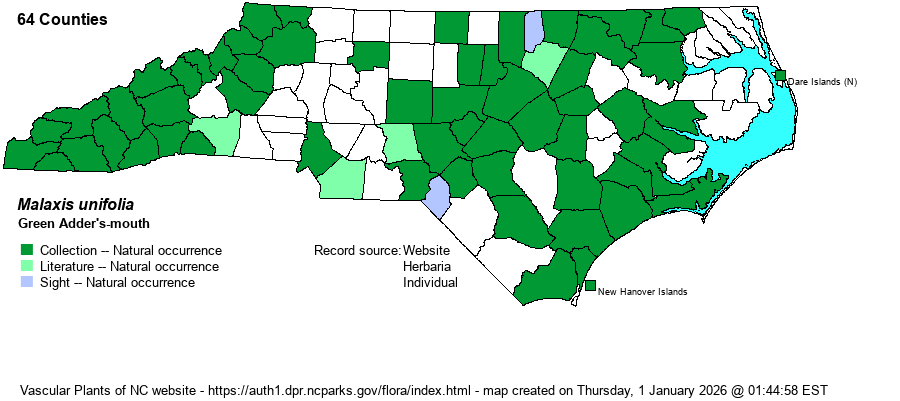| Author | Michaux | |
| Distribution | The species has a bimodal distribution in the state, occurring over most of the Coastal Plain and eastern Piedmont, and then also in the Mountains and foothills. For whatever reason (not for lack of collecting or observing), it is almost absent in the central and west-central Piedmont. It also may be absent in some far eastern and northeastern counties, especially near Albemarle Sound.
This is a very widespread species across southeastern Canada and eastern US, south to central FL and eastern TX.
| |
| Abundance | In general, it is infrequent over the Coastal Plain and eastern Piedmont, and infrequent to fairly common in the Mountains and foothills. Despite it being known from over half of the state's counties, it is not a species the average biologist will run into more than a few times a year. It is absent to very rare in some of the central and west-central Piedmont counties. | |
| Habitat | Unlike with M. spicata, which requires high pH forested conditions, this species is typically found in acidic to nearly circumneutral damp forested soils. It can be found in bottomland forests, mixed or pine forests where somewhat damp, near forested creeks, and other shaded and somewhat moist ground. In the Mountains it can also occur in bogs and wet meadows, though downstate it is found mainly in forests. | |
| Phenology | Blooms mainly from May to June, rarely to August, and fruits shortly after flowering. | |
| Identification | As with other members of the genus, this is a small deciduous species, ranging mainly less than 1 foot tall, and usually shorter. All parts of the plant are green, with the stem containing only one clasping leaf, which is ovate to elliptic, about 2-3 inches long, and half as wide. The top of the stem contains a dense "ball-like" raceme of several dozen flowers, each barely 1/8-inch across. The flowers are pale green, including the lip. In the western half of the state, where the very similar M. bayardii occurs, you must take care in separating the two. Malaxis unifolia has longer flower stalks (pedicels), growing about 5-10 mm long, notably longer than the length of each flower. Though it has longer pedicels than does M. bayardii, it also has seemingly more flowers that are crowded onto the stem, especially near the top. The flowers of M. bayardii have short and rounded lateral lobes to the lip, giving the lip a cordate or ovate look (very rounded), whereas the lateral lobes of the lip in M. unifolia are rather long and acute, giving the lip a more pointed look with straight sides. You may need to consult keys in references for additional field marks, though where both species occur, M. unifolia occurs in wetlands and moist lower slopes whereas M. bayardii grows in dry soil of upland forests. | |
| Taxonomic Comments | None
| |
| Other Common Name(s) | None | |
| State Rank | S4 | |
| Global Rank | G5 | |
| State Status | | |
| US Status | | |
| USACE-agcp | FAC link |
| USACE-emp | FAC link |

